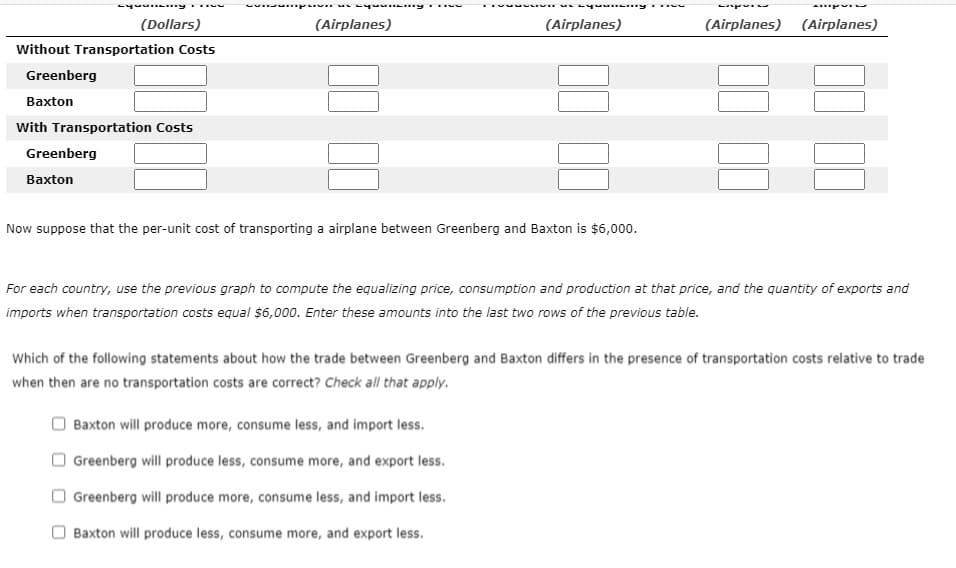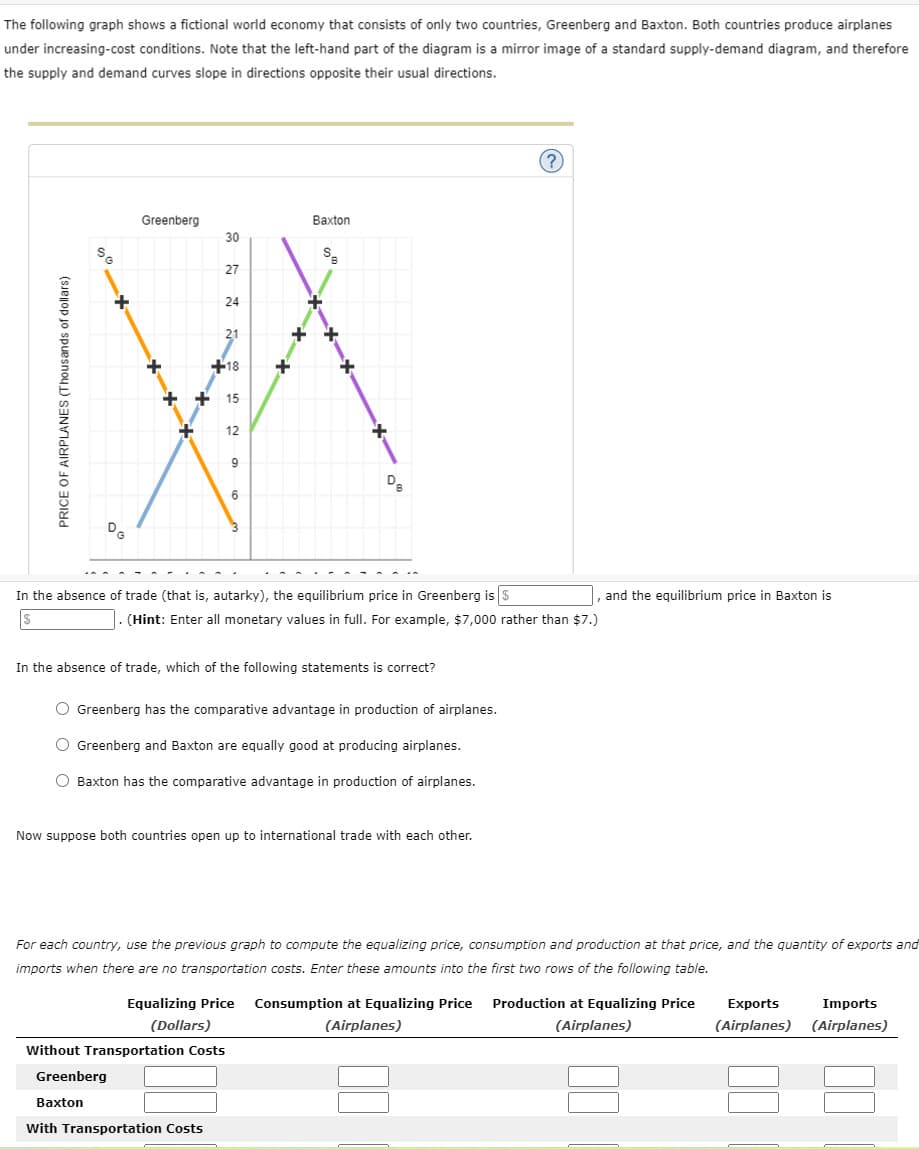(Dollars) (Airplanes) (Airplanes) (Airplanes) (Airplanes) Without Transportation Costs Greenberg Baxton With Transportation Costs Greenberg Baxton Now suppose that the per-unit cost of transporting a airplane between Greenberg and Baxton is $6,000. For each country, use the previous graph to compute the equalizing price, consumption and production at that price, and the quantity of exports and imports when transportation costs equal $6,000. Enter these amounts into the last two rows of the previous table. Which of the following statements about how the trade between Greenberg and Baxton differs in the presence of transportation costs relative to trade when then are no transportation costs are correct? Check all that apply. Baxton will produce more, consume less, and import less. Greenberg will produce less, consume more, and export less. Greenberg will produce more, consume less, and import less. Baxton will produce less, consume more, and export less. The following graph shows a fictional world economy that consists of only two countries, Greenberg and Baxton. Both countries produce airplanes under increasing-cost conditions. Note that the left-hand part of the diagram is a mirror image of a standard supply-demand diagram, and therefore the supply and demand curves slope in directions opposite their usual directions. Greenberg Baxton 30 27 24 +18 + + 15 12 In the absence of trade (that is, autarky), the equilibrium price in Greenberg is $ and the equilibrium price in Baxton is |. (Hint: Enter all monetary values in full. For example, $7,000 rather than $7.) In the absence of trade, which of the following statements is correct? O Greenberg has the comparative advantage in production of airplanes. O Greenberg and Baxton are equally good at producing airplanes. O Baxton has the comparative advantage in production of airplanes. Now suppose both countries open up to international trade with each other. For each country, use the previous graph to compute the equalizing price, consumption and production at that price, and the guantity of exports and imports when there are no transportation costs. Enter these amounts into the first two rows of the following table. Equalizing Price Consumption at Equalizing Price Production at Equalizing Price Exports Imports (Dollars) (Airplanes) (Airplanes) (Airplanes) (Airplanes) Without Transportation Costs Greenberg Baxton With Transportation Costs PRICE OF AIRPLANES (Thousands of dollars)
(Dollars) (Airplanes) (Airplanes) (Airplanes) (Airplanes) Without Transportation Costs Greenberg Baxton With Transportation Costs Greenberg Baxton Now suppose that the per-unit cost of transporting a airplane between Greenberg and Baxton is $6,000. For each country, use the previous graph to compute the equalizing price, consumption and production at that price, and the quantity of exports and imports when transportation costs equal $6,000. Enter these amounts into the last two rows of the previous table. Which of the following statements about how the trade between Greenberg and Baxton differs in the presence of transportation costs relative to trade when then are no transportation costs are correct? Check all that apply. Baxton will produce more, consume less, and import less. Greenberg will produce less, consume more, and export less. Greenberg will produce more, consume less, and import less. Baxton will produce less, consume more, and export less. The following graph shows a fictional world economy that consists of only two countries, Greenberg and Baxton. Both countries produce airplanes under increasing-cost conditions. Note that the left-hand part of the diagram is a mirror image of a standard supply-demand diagram, and therefore the supply and demand curves slope in directions opposite their usual directions. Greenberg Baxton 30 27 24 +18 + + 15 12 In the absence of trade (that is, autarky), the equilibrium price in Greenberg is $ and the equilibrium price in Baxton is |. (Hint: Enter all monetary values in full. For example, $7,000 rather than $7.) In the absence of trade, which of the following statements is correct? O Greenberg has the comparative advantage in production of airplanes. O Greenberg and Baxton are equally good at producing airplanes. O Baxton has the comparative advantage in production of airplanes. Now suppose both countries open up to international trade with each other. For each country, use the previous graph to compute the equalizing price, consumption and production at that price, and the guantity of exports and imports when there are no transportation costs. Enter these amounts into the first two rows of the following table. Equalizing Price Consumption at Equalizing Price Production at Equalizing Price Exports Imports (Dollars) (Airplanes) (Airplanes) (Airplanes) (Airplanes) Without Transportation Costs Greenberg Baxton With Transportation Costs PRICE OF AIRPLANES (Thousands of dollars)
Chapter18: International Trade And Comparative Advantage
Section: Chapter Questions
Problem 2TY
Related questions
Question

Transcribed Image Text:(Dollars)
(Airplanes)
(Airplanes)
(Airplanes)
(Airplanes)
Without Transportation Costs
Greenberg
Baxton
With Transportation Costs
Greenberg
Baxton
Now suppose that the per-unit cost of transporting a airplane between Greenberg and Baxton is $6,000.
For each country, use the previous graph to compute the equalizing price, consumption and production at that price, and the quantity of exports and
imports when transportation costs equal $6,000. Enter these amounts into the last two rows of the previous table.
Which of the following statements about how the trade between Greenberg and Baxton differs in the presence of transportation costs relative to trade
when then are no transportation costs are correct? Check all that apply.
Baxton will produce more, consume less, and import less.
Greenberg will produce less, consume more, and export less.
Greenberg will produce more, consume less, and import less.
Baxton will produce less, consume more, and export less.

Transcribed Image Text:The following graph shows a fictional world economy that consists of only two countries, Greenberg and Baxton. Both countries produce airplanes
under increasing-cost conditions. Note that the left-hand part of the diagram is a mirror image of a standard supply-demand diagram, and therefore
the supply and demand curves slope in directions opposite their usual directions.
Greenberg
Baxton
30
27
24
+18
+ + 15
12
In the absence of trade (that is, autarky), the equilibrium price in Greenberg is $
and the equilibrium price in Baxton is
|. (Hint: Enter all monetary values in full. For example, $7,000 rather than $7.)
In the absence of trade, which of the following statements is correct?
O Greenberg has the comparative advantage in production of airplanes.
O Greenberg and Baxton are equally good at producing airplanes.
O Baxton has the comparative advantage in production of airplanes.
Now suppose both countries open up to international trade with each other.
For each country, use the previous graph to compute the equalizing price, consumption and production at that price, and the guantity of exports and
imports when there are no transportation costs. Enter these amounts into the first two rows of the following table.
Equalizing Price
Consumption at Equalizing Price
Production at Equalizing Price
Exports
Imports
(Dollars)
(Airplanes)
(Airplanes)
(Airplanes)
(Airplanes)
Without Transportation Costs
Greenberg
Baxton
With Transportation Costs
PRICE OF AIRPLANES (Thousands of dollars)
Expert Solution
Step 1
"Since you have asked a question with multiple sub-parts, we will solve the first three sub-parts for you. If you want other sub-parts to be solved, Please repost the question by specifying the number of the sub-parts"
Meaning of Cost:
The term cost refers to the situation under which a firm occurs various expenses during the process of production, these expenses are the cost of raw materials, cost of machinery, cost of workers, the cost of packaging, and cost of transportation.
Thus the above process is known as the cost for a firm.
Trending now
This is a popular solution!
Step by step
Solved in 3 steps

Knowledge Booster
Learn more about
Need a deep-dive on the concept behind this application? Look no further. Learn more about this topic, economics and related others by exploring similar questions and additional content below.Recommended textbooks for you


Principles of Economics, 7th Edition (MindTap Cou…
Economics
ISBN:
9781285165875
Author:
N. Gregory Mankiw
Publisher:
Cengage Learning

Principles of Macroeconomics (MindTap Course List)
Economics
ISBN:
9781285165912
Author:
N. Gregory Mankiw
Publisher:
Cengage Learning


Principles of Economics, 7th Edition (MindTap Cou…
Economics
ISBN:
9781285165875
Author:
N. Gregory Mankiw
Publisher:
Cengage Learning

Principles of Macroeconomics (MindTap Course List)
Economics
ISBN:
9781285165912
Author:
N. Gregory Mankiw
Publisher:
Cengage Learning